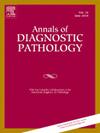Orbital masses as a rare presentation of Rosai-Dorfman disease: Clinicopathologic characterization of five cases
IF 1.5
4区 医学
Q3 PATHOLOGY
引用次数: 0
Abstract
Rosai-Dorfman disease (RDD) is a rare, non-Langerhans cell histiocytosis. Most cases present with marked, non-tender lymphadenopathy due to the proliferation of atypical histiocytes. A minority of cases involves extranodal sites and can present as bone lesions, skin rashes, pulmonary nodules, and rarely orbital masses. Orbital involvement in RDD is rare and may infrequently present as an isolated tumor mass without lymphadenopathy. This study aims to better characterize this uncommon presentation of this rare disease. Five cases of orbital RDD were identified from the last 18 years and the clinical characteristics of each case were compared with histopathological findings. Three men and two women ages 12–36 presented with complaints of eye swelling and/or vision changes. One patient had a history of neurofibromatosis type I and inflammatory pseudotumors while the other four had no signs of systemic disease or other sites of extranodal involvement at the time of presentation. Masses ranged in size from 1.0 cm to 3.5 cm and primarily involved the superior orbit. Resected lesions all displayed characteristic findings of admixed atypical histiocytes, lymphocytes, and plasma cells with a fibrotic background. Emperipolesis was seen in all cases. Immunostaining for S100 and CD68 was diffusely positive in the histiocyte population. Clinical follow-up was obtained for 4 of 5 patients: all four were disease-free at 1 to 15 years after resection. RDD should be considered in the differential for patients with orbital masses, even in the absence of lymphadenopathy or signs of systemic disease.
眼眶肿块是罗赛-多夫曼病的一种罕见表现:五例病例的临床病理学特征。
罗赛-多夫曼病(RDD)是一种罕见的非朗格汉斯细胞组织细胞增生症。由于非典型组织细胞增生,大多数病例表现为明显、无触痛的淋巴结肿大。少数病例累及结节外部位,可表现为骨病变、皮疹、肺部结节,很少出现眼眶肿块。眼眶受累在 RDD 中较为罕见,很少表现为无淋巴结病的孤立肿瘤肿块。本研究旨在更好地描述这种罕见疾病的罕见表现。研究人员从过去 18 年中发现了五例眼眶 RDD 病例,并将每例病例的临床特征与组织病理学结果进行了比较。三位男性和两位女性患者的年龄在 12-36 岁之间,主诉眼睛肿胀和/或视力改变。其中一名患者有神经纤维瘤病 I 型和炎性假瘤病史,其他四名患者在发病时没有全身性疾病或其他结节外受累部位的迹象。肿块大小从1.0厘米到3.5厘米不等,主要累及眼眶上部。切除的病灶均显示出非典型组织细胞、淋巴细胞和浆细胞混杂的特征性结果,并伴有纤维化背景。所有病例均可见眼睑外翻。组织细胞群中的 S100 和 CD68 免疫染色呈弥漫阳性。对 5 例患者中的 4 例进行了临床随访:所有 4 例患者在切除术后 1 至 15 年间均未发病。对于眼眶肿块患者,即使没有淋巴结病或全身性疾病的迹象,也应将 RDD 列入鉴别诊断的考虑范围。
本文章由计算机程序翻译,如有差异,请以英文原文为准。
求助全文
约1分钟内获得全文
求助全文
来源期刊
CiteScore
3.90
自引率
5.00%
发文量
149
审稿时长
26 days
期刊介绍:
A peer-reviewed journal devoted to the publication of articles dealing with traditional morphologic studies using standard diagnostic techniques and stressing clinicopathological correlations and scientific observation of relevance to the daily practice of pathology. Special features include pathologic-radiologic correlations and pathologic-cytologic correlations.

 求助内容:
求助内容: 应助结果提醒方式:
应助结果提醒方式:


